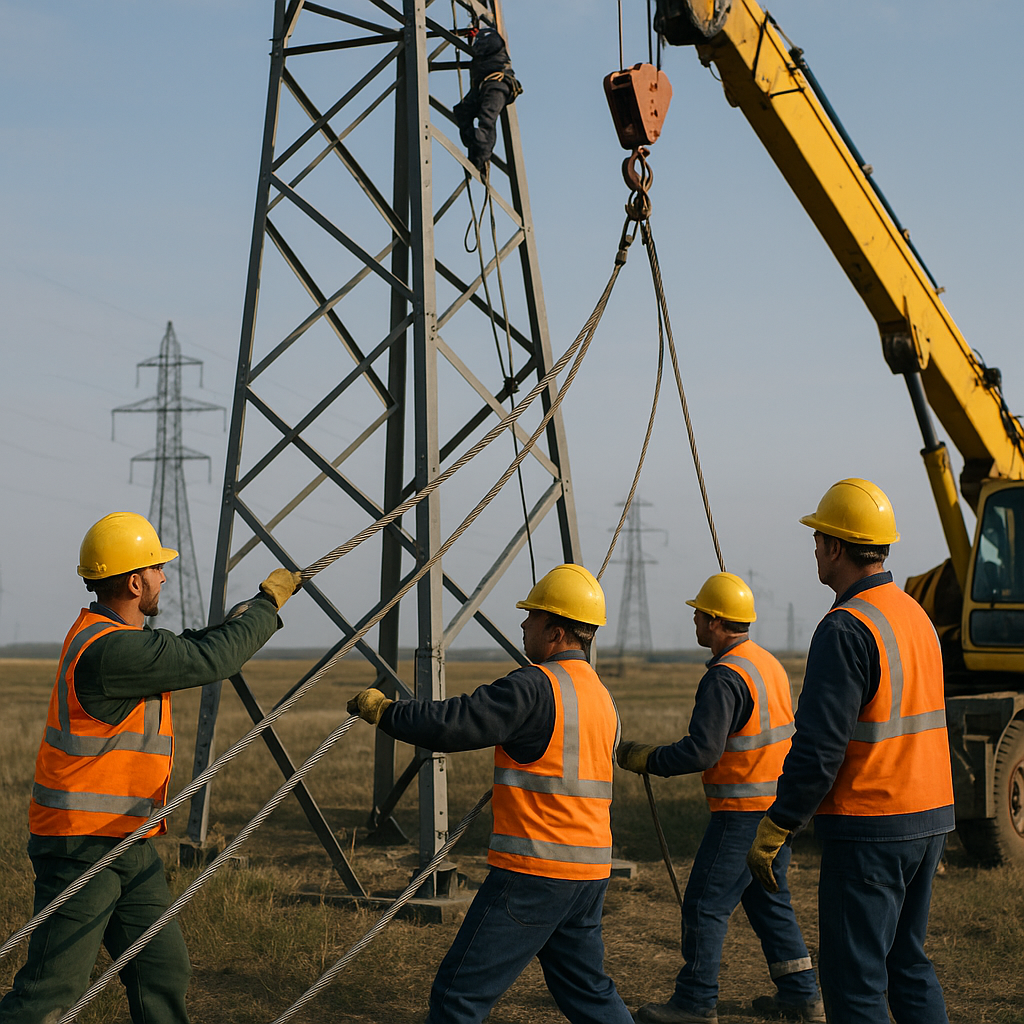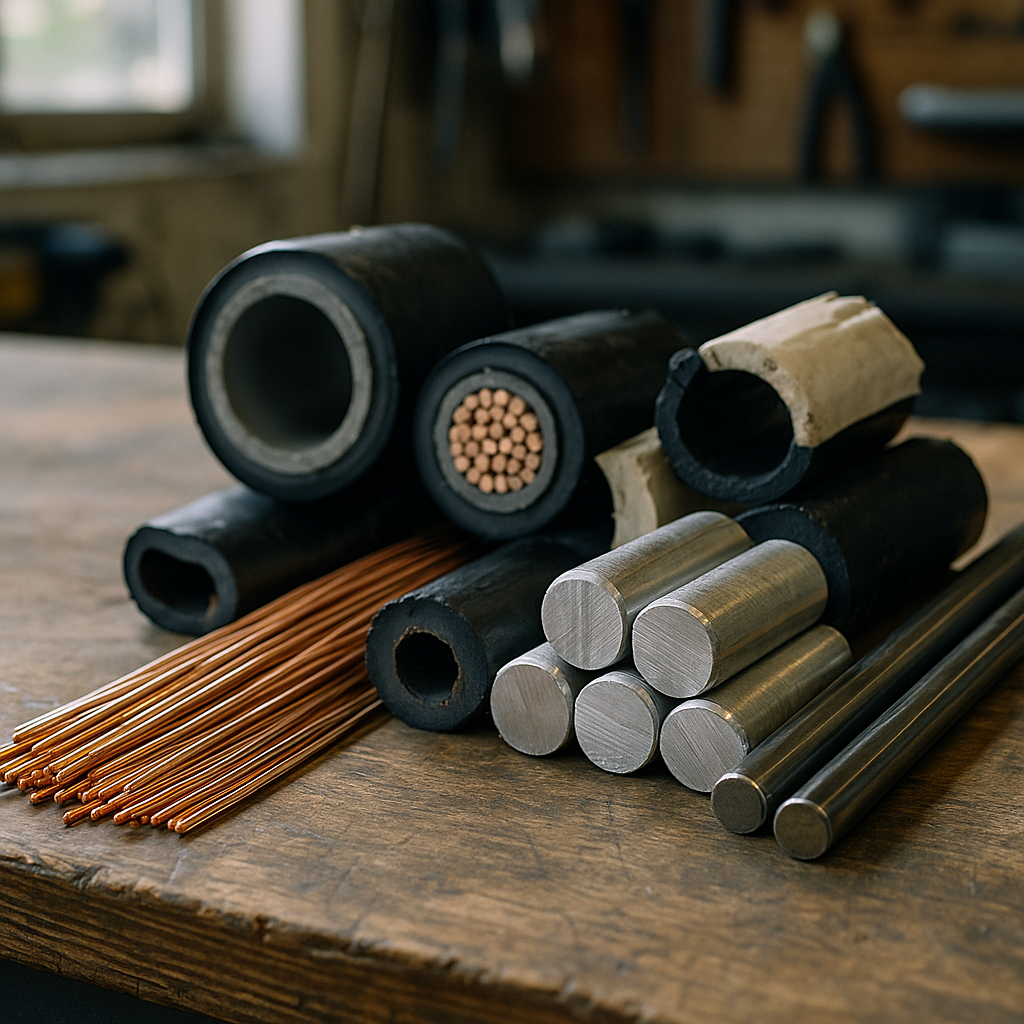5901 Botham Jean Blvd, Dallas, TX 75215
The Growing Need for Recycling High-Voltage Cables and Transmission Lines
July 30, 2025Each year, thousands of miles of high-voltage cables and transmission lines reach the end of their operational life. These critical components form the backbone of our electrical grid and require proper handling when decommissioned. Recycling these materials is both an environmental necessity and an economic opportunity.
High-voltage cables and transmission lines contain valuable materials that can be reused. Copper and aluminum conductors, which make up significant portions of these components, are especially valuable in a resource-constrained world. The metal content in these cables can be fully recovered and reused in new products, preventing unnecessary mining of virgin materials.
The environmental case for recycling is compelling. Improper disposal of transmission infrastructure wastes finite resources and creates unnecessary landfill waste. Traditional disposal methods often involve shipping materials overseas for processing, which generates significant carbon emissions. Modern recycling approaches can reduce these emissions by up to 90% while recovering materials with substantial economic value.
How Are High-Voltage Cables and Transmission Lines Decommissioned?

Decommissioning high-voltage cables and transmission lines is a multi-step process requiring careful planning, safety protocols, and specialized equipment. This critical phase begins when utility operators or grid managers determine that a line has reached the end of its functional life—due to age, damage, or system upgrades. The removal process ensures valuable materials can be efficiently recycled while minimizing environmental impact and safety risks.
Assessment and Planning
Before any physical removal, engineers conduct a thorough assessment to map the line’s route, identify potential hazards, and evaluate the structural integrity of both the cables and support towers. Permitting and regulatory compliance are reviewed to ensure all local, state, and federal requirements are met, especially for lines crossing sensitive environments or public lands.
Safe Power Isolation and Disconnection
All cables and equipment are carefully de-energized to prevent electrical hazards. Specialized crews use lockout/tagout procedures and test the lines for residual voltage. The cables are then disconnected from substations and associated infrastructure.
Physical Removal and Segmentation
Transmission cables are often removed using cable pulling machines, winches, and hydraulic cutters. Depending on their location, conductors may be lowered from towers or excavated from underground. The cables are segmented into manageable lengths for transport. Structures such as towers and insulators are dismantled and sorted for metal recycling or landfill disposal.
Sorting and Pre-Processing
Once removed, cables and line hardware are sorted by material type—copper, aluminum, steel, insulation, and armoring. Pre-processing may involve stripping insulation, cutting steel cores, and bundling conductors to optimize downstream recycling. This step improves recovery rates and reduces contamination of valuable metals.
Effective decommissioning is crucial for both safety and sustainability, laying the foundation for high-value recycling and resource recovery in the transmission sector.
Challenges and Best Practices in Transmission Line Recycling
Recycling high-voltage cables and transmission lines offers considerable opportunities, but also presents unique challenges that must be addressed to maximize resource recovery and minimize environmental risks. Understanding these obstacles—and the best practices to overcome them—is essential for utilities, contractors, and recyclers alike.
Handling Composite and Mixed-Material Cables
Modern transmission lines are often constructed with complex combinations of metals, polymers, and specialty coatings. Efficiently separating these materials can be labor-intensive and requires advanced equipment. For example, cables with cross-linked polyethylene (XLPE) insulation demand specialized stripping or chemical processing to recover clean metals.
Managing Hazardous Substances
Some older cables contain hazardous materials such as lead, polychlorinated biphenyls (PCBs), or oil-based dielectric fluids. Safe removal, transport, and disposal of these substances are strictly regulated and require trained personnel and proper documentation. Failure to address hazardous content can result in environmental contamination and regulatory penalties.
Transportation and Logistics
Decommissioned transmission lines are often heavy and bulky, complicating logistics. Transporting cables from remote or rugged terrain to recycling facilities may require specialized vehicles or on-site processing. Coordination with local authorities and landowners is crucial to ensure the safe, efficient movement of materials.
Best Practices for Efficient and Sustainable Recycling
- Utilize on-site separation technologies to reduce transportation volume and improve material purity.
- Invest in automated sorting systems to enhance recovery rates and reduce manual labor.
- Partner with certified recyclers who follow environmental and safety regulations.
- Document every step of the removal and recycling process for regulatory compliance.
- Implement continuous training for crews on handling hazardous or legacy materials.
By adopting these best practices, the energy sector can overcome the barriers to large-scale cable and transmission line recycling, ensuring that valuable resources are kept in use and environmental risks are minimized.
What Materials Can Be Recovered from High-Voltage Cables and Transmission Lines?

High-voltage cables and transmission lines are valuable repositories of recyclable materials. When these components reach the end of their operational life, they can yield significant quantities of valuable resources through proper recycling processes. Let’s examine the recoverable materials and their value in the circular economy.
Primary Recoverable Components
Transmission lines and high-voltage cables contain several high-value materials designed in layers to efficiently transmit electricity while maintaining safety and durability. The main recoverable components include:
- Aluminum conductors – Most modern overhead transmission lines use aluminum alloy strands due to their lightweight properties and cost-effectiveness compared to copper. These conductors yield approximately 1 kg of aluminum per meter of conductor when recycled.
- Copper conductors – Found in some older transmission lines and many underground cables, copper remains highly valuable in recycling markets due to its excellent conductivity and widespread industrial applications.
- Steel cores – Many overhead conductors use steel-reinforced designs (ACSR – Aluminum Conductor Steel Reinforced) where steel provides structural strength while aluminum conducts electricity. These steel cores can be separated and recycled independently.
- Insulating materials – Various polymers and plastics serve as insulation in cables, including polyethylene, cross-linked polyethylene (XLPE), and polypropylene (PP). While historically these materials were often landfilled or incinerated, advanced recycling technologies now enable their recovery.
In underground high-voltage cables, additional materials may include metal sheaths, protective armoring, and in some cases, dielectric fluids that can also be recovered and processed.
[[artifact_table]] Cross-section composition of typical high-voltage transmission cables [[/artifact_table]]The Value Proposition of Metal Recovery
The metals recovered from transmission infrastructure hold substantial economic and environmental value. Aluminum and copper are particularly valuable resources:
Recycling these metals significantly reduces energy consumption compared to primary production. Aluminum recycling requires only about 5% of the energy needed for producing new aluminum from bauxite ore. Similarly, copper recycling demands far less energy than mining and processing virgin copper ore.
Modern recycling technologies now enable highly efficient recovery processes. For example, Australian electricity transmission company Transgrid has implemented a system that separates the aluminum outer layer from the steel core of conductors on-site. This innovation yields substantial aluminum recovery while reducing emissions associated with recycling by up to 90%.
Innovative Recycling Technologies
Recent technological advances have significantly improved the efficiency of transmission line recycling. One notable example is the ZECK Al/Steel Separator (ZAS) machine, which feeds conductors under tension to separate the outer aluminum layer from the steel core without damaging either component.
This process cuts the aluminum into small pieces (30-70mm) that can be directly sent for smelting into new products, while the intact steel core is wound onto cable drums for separate recycling. Such on-site processing eliminates the need to ship materials overseas for separation, reducing both costs and environmental impact.
The economic benefits are substantial. Recycling transmission lines can yield returns up to three times the standard scrap metal rates—reaching approximately $2-3 per kilogram for processed materials. This economic incentive, combined with the environmental benefits, makes the recycling of transmission infrastructure increasingly attractive to utilities and waste management companies.
Environmental Benefits
Recovering materials from high-voltage transmission infrastructure offers several environmental advantages:
- Reduces the need for new mining operations, which often cause significant ecological disruption
- Conserves finite natural resources like copper and bauxite ore
- Decreases energy consumption associated with primary metal production
- Minimizes waste sent to landfills
- Lowers carbon emissions from the overall material life cycle
As utilities upgrade aging infrastructure or replace conventional conductors with advanced alternatives like carbon fiber composite conductors, the volume of recyclable transmission materials will continue to grow. Implementing efficient recycling practices ensures these valuable resources remain in the circular economy rather than becoming waste.
Conclusion: The Future of High-Voltage Cable and Transmission Line Recycling

The recycling of high-voltage cables and transmission lines is a crucial aspect of sustainable waste management within the energy sector. With global electricity demand increasing, cable waste is also growing. Technologies and methods for recycling these materials have evolved significantly, progressing from mechanical processing to advanced AI-driven sorting systems.
The future of high-voltage cable recycling is likely to be influenced by continued innovation in separation technologies, increased automation, and enhanced industry collaboration. Circular economy principles driving these developments not only conserve valuable metals like copper and aluminum but also minimize the environmental impact of waste disposal. By recovering these materials, the energy sector can significantly decrease its carbon footprint while creating economic value from what was once considered waste. For organizations with high-voltage cable and transmission line materials ready for disposal, contact Okon Recycling at 214-717-4083 to explore responsible recycling solutions tailored to your specific needs.
